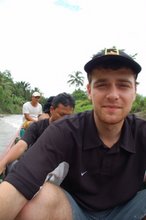 Kuda Lumping isn’t something you see everyday and it is not a very Acehnese ceremony. It is a distinctly Javanese festival and I have never seen one before but from the sound of it, it has to do with horses (‘Kuda’ means horse). Perhaps it was my lucky day because today in Damai, a small village along the coastline of
Kuda Lumping isn’t something you see everyday and it is not a very Acehnese ceremony. It is a distinctly Javanese festival and I have never seen one before but from the sound of it, it has to do with horses (‘Kuda’ means horse). Perhaps it was my lucky day because today in Damai, a small village along the coastline of
Arriving in the village I could see the gamelan (orchestra) gathered under the shade preparing for their march along the road into the center of the village. Out ran a dozen young men with fake, flat horses. They were all wearing dark shades, pink shirts and traditional hats. The gamelan rushed to their feet and the two-step march began.
Then out came the Barong (a mask attached to a large cap with two people underneath) doing the same two-step. Arriving in the village center there was a dramatic end with the Barong mask biting violently with a sharp clapping sound. We sat down and the speeches began.
 The speeches were incredibly formal and not many people listened. Each speech was also interrupted by a prayer and this was the first time I got to see the Muezzin perform his piece. It was actually rather calming and made me think about how this tune has entranced followers into one of the largest religions in the world. At that point the woman next to me turned to me and asked, “are you a Muslim?” After politely saying no she went on. “You should come move into the community, become a good Muslim and learn how to pray like we do. I mean you don’t want to burn in hell, do you?”
The speeches were incredibly formal and not many people listened. Each speech was also interrupted by a prayer and this was the first time I got to see the Muezzin perform his piece. It was actually rather calming and made me think about how this tune has entranced followers into one of the largest religions in the world. At that point the woman next to me turned to me and asked, “are you a Muslim?” After politely saying no she went on. “You should come move into the community, become a good Muslim and learn how to pray like we do. I mean you don’t want to burn in hell, do you?”
 I had never heard of Muslims talk about hell before and I had never been approached that way by a Muslim before; nor have I ever heard of anyone being spoken to in that manner by a Muslim.
I had never heard of Muslims talk about hell before and I had never been approached that way by a Muslim before; nor have I ever heard of anyone being spoken to in that manner by a Muslim.
I chose not to think about it anymore. Finally there was more dancing. The youth did some Acehnese routines to some electronic music and then the Kuda Lumping started up again. This time, I could see people’s attention being drawn to a person who appeared to be violently shaking. He was Mabuk (lit. dizzy/drunk—but with the connotation that he had fallen into a trance and “been infiltrated by Setan—demons”). He had fallen into a trance. He seemed to have lost his senses and had taken on the form of an animal, licking the air and staying very close to the ground. He then got on the ground and began rolling around in the mud. It seemed like a very set ceremony as the people knew exactly what to provide him and they were dousing him with water as well. Finally the “entranced” demanded makeup and lipstick. He started acting like a girl and doing other funny things. Some of the non-believers I was with, said that this was just an opportunity for people to express themselves—because within Sharia’a law they are never allowed to do such things. I chose not to take sides.
 Then another of the Kuda Lumping dancers fell into trance. He was shaking violently and grabbed a whip and started running around. Apparently if you were wearing red you weren’t supposed to get close. Even with my white T-shirt, I decided to stay in the back anyway.
Then another of the Kuda Lumping dancers fell into trance. He was shaking violently and grabbed a whip and started running around. Apparently if you were wearing red you weren’t supposed to get close. Even with my white T-shirt, I decided to stay in the back anyway.











